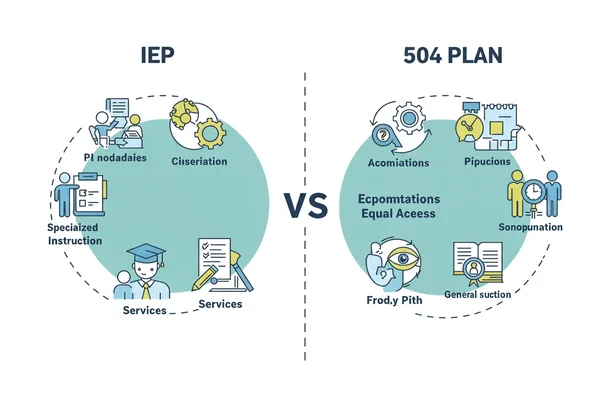Dyslexia School Accommodations: IEPs, 504 Plans, and Understanding the Dyslexia Test Process
As a parent, few things are more important than your child's education. If you've noticed your child struggling with reading or spelling, it’s natural to feel concerned and search for answers. You're looking for the right support to help them thrive academically and build confidence. Understanding dyslexia school accommodations is a powerful first step in this journey. But many parents wonder, How to test for dyslexia? and what comes next. This guide will demystify school support systems, explain critical tools like IEPs and 504 Plans, and empower you to become your child’s most effective advocate.
The journey begins with understanding. Identifying potential signs of reading challenges early can make a significant difference. A great starting point is to get a baseline of your child's skills. This information can be invaluable when you begin conversations with their school, providing you with concrete observations to share.

Understanding Dyslexia School Support in Educational Settings
When a child has dyslexia, the standard classroom environment may not be enough to ensure their success. Dyslexia school support is not about lowering expectations; it's about leveling the playing field. It involves implementing strategies and tools that allow students with dyslexia to access the curriculum and demonstrate what they know, bypassing their specific reading-related challenges. This support is a legal right and a pedagogical necessity.
What Are Common School Accommodations for Dyslexia?
Accommodations are adjustments that change how a student learns, not what they learn. They are designed to remove barriers presented by a learning difference. While every child's needs are unique, here are some of the most common school accommodations for dyslexia:
-
Extra Time: Providing more time on tests and assignments allows students to process written information without the pressure of a ticking clock.
-
Audiobooks and Text-to-Speech: Tools that read text aloud enable students to access grade-level content and absorb information through listening, a significant strength for many with dyslexia.
-
Speech-to-Text Software: Dictation tools allow students to get their thoughts onto paper without the struggle of spelling and writing, enabling them to express their knowledge more freely.
-
Modified Assignments: This could mean fewer spelling words, reduced reading load, or providing notes and outlines from the teacher.
-
Alternative Assessment Formats: Allowing for oral presentations, video projects, or dioramas instead of written reports gives students a chance to showcase their understanding in different ways.

Why Proactive Support is Crucial for Learning Potential
Without the right support, children with dyslexia can fall into a difficult cycle. They may struggle in class, feel frustrated, and begin to believe they aren't smart, which can damage their self-esteem and motivation. Proactive support interrupts this negative pattern. By providing accommodations, we help children experience success and build confidence, which is essential for unlocking their full learning potential. Early identification and intervention are key. An initial free online dyslexia test can provide the insights needed to start this crucial conversation and ensure your child gets help sooner rather than later.
Navigating IEP vs. 504 Plans for Dyslexia
When you start exploring school support, you will inevitably hear the terms "IEP" and "504 Plan." While both are legal documents designed to provide support, they serve different functions. Understanding the distinction is vital when advocating for an IEP for dyslexia or a 504 plan dyslexia.
The Basics of an Individualized Education Program (IEP)
An Individualized Education Program (IEP) is a legal document under the Individuals with Disabilities Education Act (IDEA). To qualify for an IEP, a student's dyslexia must be significant enough that they require specialized, direct instruction to make progress in the general education curriculum. The IEP basics include:
- Eligibility: A formal evaluation must determine that the student has one of 13 specified disabilities (dyslexia falls under "Specific Learning Disability") and that it adversely affects their educational performance.
- Content: An IEP outlines specific, measurable annual goals, details the specialized instruction and related services (like speech therapy or occupational therapy) the child will receive, and specifies how their progress will be tracked.
- Team: The IEP is created by a team that includes parents, general education teachers, special education teachers, a school district representative, and often the student.
How a 504 Plan Can Support Your Child with Dyslexia
A 504 Plan is governed by Section 504 of the Rehabilitation Act of 1973, a civil rights law. It is designed to ensure that a student with a disability has equal access to the learning environment. A child may qualify for a 504 Plan if their dyslexia substantially limits a major life activity, such as reading, but they may not require specialized instruction to succeed. The primary 504 plan benefits come from providing accommodations within the general classroom. This can include things like extra time on tests, preferential seating, or the use of assistive technology.
Deciding Which Plan is Right for Your Child
The key difference between an IEP vs 504 dyslexia plan lies in the level of need. Does your child need changes to the curriculum and specialized instruction (IEP), or do they need accommodations to access the standard curriculum (504 Plan)? The school’s evaluation team will make the final determination, but as a parent, your input is critical. Arming yourself with information, including results from an initial dyslexia screening, helps you participate meaningfully in this decision-making process.

Advocating Effectively for Your Child's Education
As a parent, you are your child's first and most important teacher, and when it comes to school, you are their chief advocate. Advocating for your child's education means working collaboratively with the school to create a supportive and effective learning environment. This requires preparation, clear communication, and persistence.
Communicating with Teachers and School Staff
Effective advocacy begins with a positive relationship. When talking to teachers about dyslexia, approach the conversation as a partnership.
- Be Prepared: Bring specific examples of your child's struggles and strengths. A report from a screening tool can provide objective data to start the discussion.
- Be Collaborative: Frame your requests with "we" statements, such as "How can we work together to help my child with their reading fluency?"
- Listen: Teachers have valuable insights into your child's classroom performance. Listen to their observations to build a complete picture.
Preparing for School Meetings and Reviews
Formal meetings can feel intimidating. Proper school meeting preparation will boost your confidence and ensure the meeting is productive.
- Organize Your Documents: Create a binder with your child's report cards, work samples, teacher communications, and any assessment results.
- Write Down Your Goals: What do you hope to achieve with this meeting? Write down your top 2-3 goals and your key questions.
- Know Your Rights: Familiarize yourself with your parental rights under IDEA and Section 504. Parent Training and Information Centers (PTIs) offer free resources in every state.
Documenting Progress and Communication for Your Records
One of the most powerful tools in advocacy is documentation. Keeping detailed records is essential for tracking your child's academic progress and ensuring accountability.
-
Keep a Communication Log: Note the date, person, and summary of every phone call and conversation.
-
Follow Up in Writing: After an important conversation, send a brief, polite email summarizing what was discussed and any agreed-upon actions. This creates a paper trail.
-
Save Everything: File away all emails, meeting notes, and reports in your binder. This documentation is invaluable for tracking what works and what doesn't over time. You can start your free test today to get the first piece of documentation.

Taking Action: Your Next Steps for Dyslexia Support at School
Navigating the world of school accommodations can feel complex, but it is a manageable and incredibly rewarding process. By understanding the types of support available, knowing the difference between an IEP and a 504 Plan, and learning how to advocate effectively, you can profoundly impact your child's educational journey. You are not just seeking help for today; you are building a foundation of support and self-advocacy that will serve your child for a lifetime.
The first step is often the hardest, but it's also the most important. Taking action begins with gathering information. We encourage you to start the dyslexia test now. This free, professional screening tool is designed to give you the initial insights you need to begin a constructive conversation with your child's school and unlock their true reading potential.
Common Questions About Dyslexia Accommodations in School
Can schools test for dyslexia?
Yes, but they may use different terminology. Under federal law (IDEA), public schools are required to evaluate a child who is suspected of having a disability that impacts their learning. While they might not use the specific word "dyslexia," they will conduct a comprehensive evaluation to determine if the child qualifies for services under the category of a "Specific Learning Disability," which includes dyslexia.
What is the cost of a formal dyslexia assessment?
If the evaluation is conducted by your child's public school, there is no cost to you. Private educational psychologists or specialists can also conduct formal assessments, but the cost can vary significantly, often ranging from several hundred to a few thousand dollars. This is why using a free, reliable screening tool can be a valuable first step to identify potential risks before committing to a costly private evaluation.
How can I help my child with dyslexia succeed in school?
Success is a team effort. The most crucial things you can do are to ensure they receive the right accommodations through an IEP or 504 plan, advocate for them consistently, and create a supportive home environment. Celebrate their effort and strengths, help them with homework using dyslexia-friendly strategies, and always remind them that dyslexia has nothing to do with intelligence.
Is an online dyslexia screening test useful for school discussions?
Absolutely. While it is important to remember that a screening is not a formal diagnosis, it is an incredibly useful tool for several reasons. It provides objective, data-based evidence to share with teachers, moving the conversation from "I'm worried" to "Here's what I'm seeing." It demonstrates that you have taken a proactive step, and its results can help you formulate specific questions for the school team, making you a more informed and effective advocate. Feel free to begin the screening today.